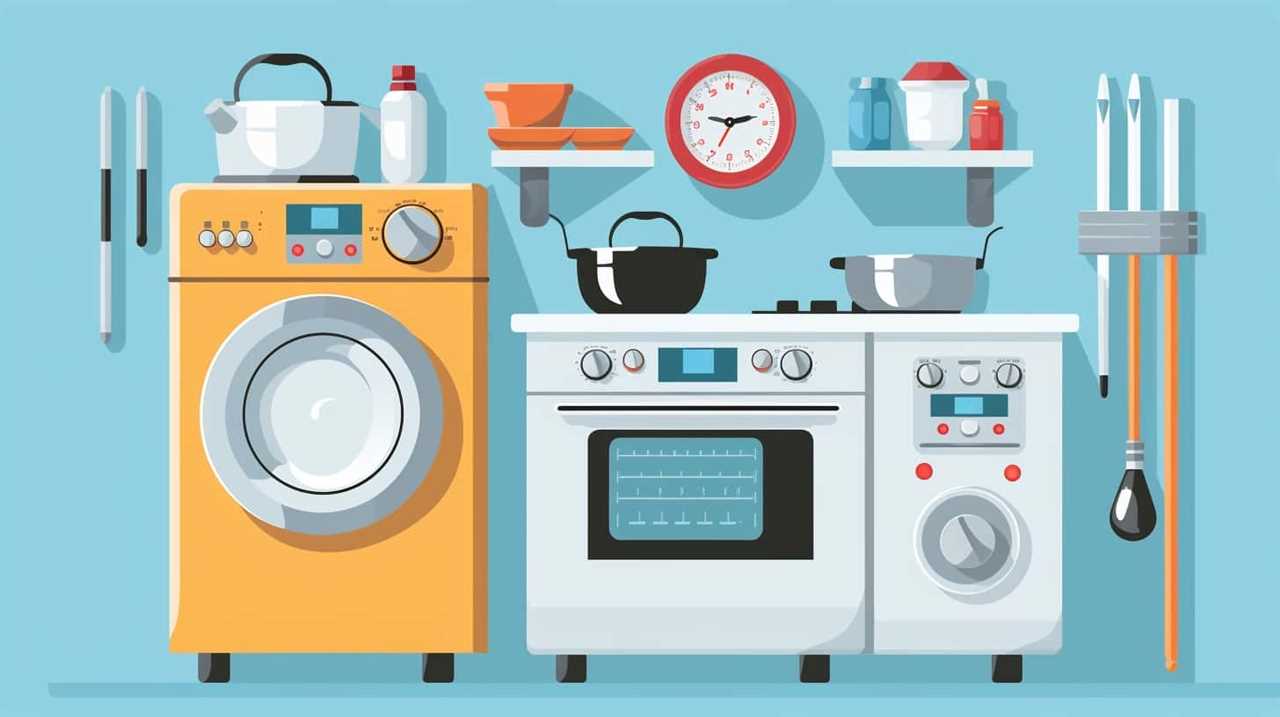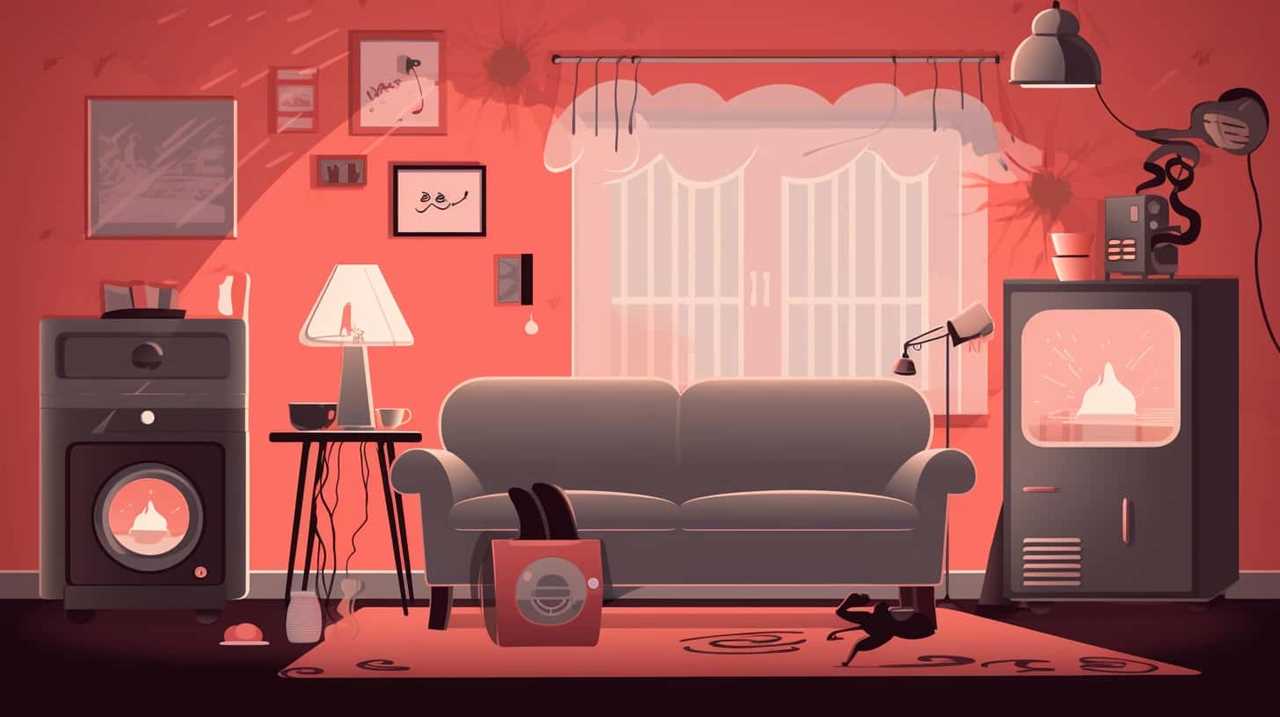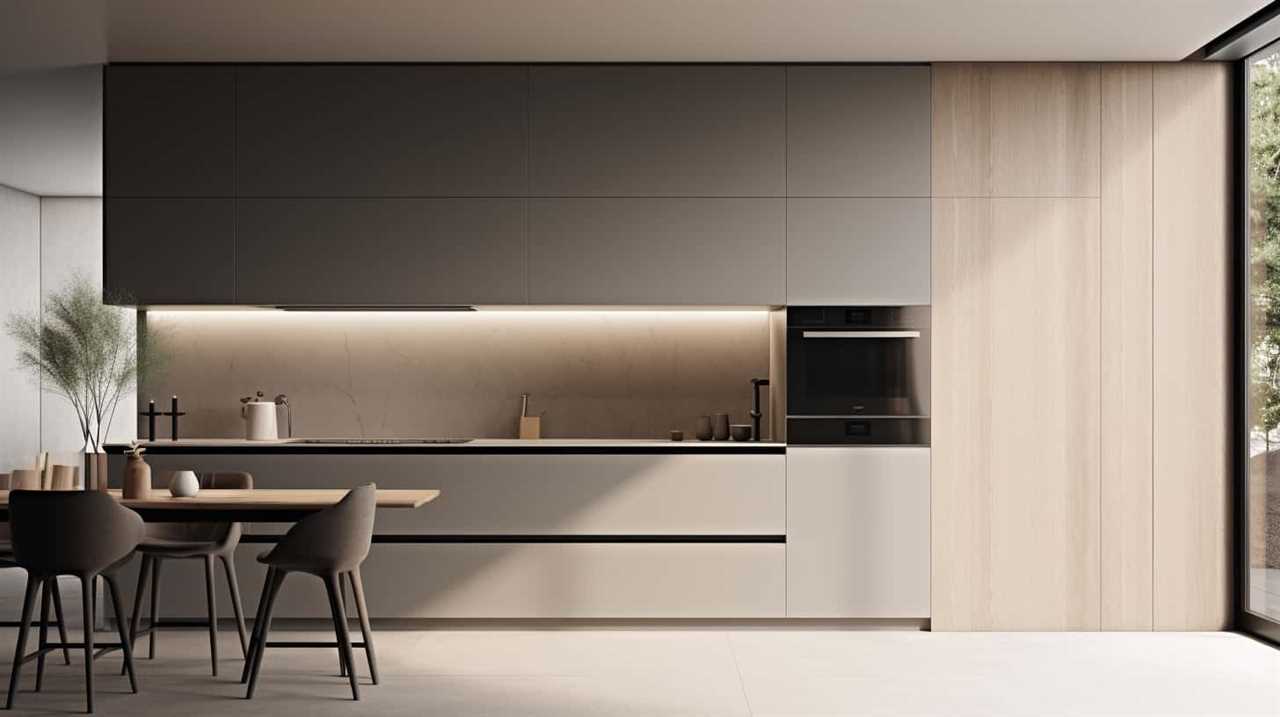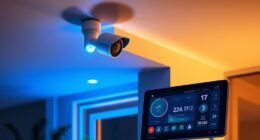Are you aware that appliances continue to consume power even when they are switched off? This is a fact! In the United States, the average household wastes up to 10% of its energy on standby power.
But fear not, because in this article, we will delve into the world of standby power and unveil the secrets behind this phantom load. Get ready to become a master of energy efficiency as we explore ways to reduce standby power and take control of our appliance power consumption.
Key Takeaways
- Appliances consume energy even when turned off, known as standby power or phantom power.
- Standby power can account for up to 10% of household energy consumption.
- Using power strips with switches or unplugging devices can minimize standby power consumption.
- Some appliances continue to draw a small amount of power even in ‘Off’ mode.
Understanding Standby Power
When we leave our appliances idle, they continue to consume energy in a phenomenon known as standby power. Understanding energy waste and minimizing standby power is crucial in our quest for energy efficiency.
Standby power, also called phantom or vampire power, refers to the energy consumed by electronic devices when they aren’t in use but still plugged in. This includes appliances like televisions, computers, and even phone chargers. It may seem insignificant, but standby power can account for a significant portion of our energy consumption.

To minimize standby power, we can adopt simple habits like unplugging devices when not in use or using power strips with switches to completely cut off the power supply. By understanding the impact of standby power and taking proactive steps to minimize it, we can make a meaningful difference in reducing energy waste.
Transitioning into the next section, let’s debunk the myth of ‘off’ mode and explore how appliances still draw power even when turned off.
The Myth of "Off" Mode
Now let’s talk about the myth of ‘Off’ mode and how it relates to standby power consumption, phantom energy usage, and vampire power drain.
Many people believe that when they turn off their appliances, they’re completely disconnected from the power source and don’t consume any electricity. However, this isn’t the case. Even in ‘Off’ mode, appliances often continue to draw power, albeit in smaller amounts.

This phenomenon is known as standby power consumption, phantom energy usage, or vampire power drain.
Standby Power Consumption
We often underestimate the amount of standby power consumption that appliances have, even when they’re in ‘off’ mode. Standby power, also known as vampire or phantom energy, refers to the electricity that devices continue to draw when not in use but still plugged in.
This can happen because appliances are designed to respond to remote controls or to be ready for instant use. Standby power consumption can account for a significant portion of a household’s energy usage, leading to higher electricity bills and unnecessary environmental impact.
Implementing standby power management techniques, such as using power strips with on/off switches or unplugging devices when not in use, can result in significant standby power savings. However, it’s important to note that even in ‘off’ mode, some appliances continue to draw a small amount of power.

This brings us to the next topic of discussion: phantom energy usage.
Phantom Energy Usage
Continuing from the previous subtopic on standby power consumption, it’s important to address the issue of phantom energy usage in appliances, which occurs even when they’re in ‘off’ mode. This phenomenon is commonly known as ‘vampire power’ or ‘standby power.’
Here are four key points to consider when it comes to measuring phantom energy and reducing vampire power:
- Standby power can account for up to 10% of a household’s energy consumption, resulting in unnecessary energy waste and higher electricity bills.
- Many appliances, such as televisions, computers, and game consoles, continue to draw power even when turned off, as they stay in a standby mode waiting for a signal to turn on.
- Using a power meter or smart power strip can help you measure the phantom energy used by your appliances, allowing you to identify energy-hungry devices and take appropriate action.
- To reduce vampire power, unplug appliances when not in use, or use power strips with a switch to completely cut off power to multiple devices at once.
Vampire Power Drain
Phantom energy usage is a significant concern when it comes to appliances, as it results in a vampire power drain even when they’re in ‘off’ mode. Many people believe that appliances consume no energy when turned off, but this is a common misconception. In reality, appliances continue to draw a small amount of power to maintain standby functions such as clocks, timers, and remote control capabilities.

This standby energy usage, also known as vampire power drain, can add up over time and contribute to unnecessary energy consumption and higher electricity bills. To combat this issue, there are several vampire power solutions available. One effective way to reduce standby energy is by using smart power strips, which automatically cut off power to appliances when they aren’t in use.
Additionally, choosing energy-efficient appliances and unplugging devices when not in use can also help minimize vampire power drain. By implementing these measures, homeowners can take control of their energy usage and reduce unnecessary standby power consumption.
Unveiling Phantom Load
Uncovering the hidden power consumption of appliances when not in use is a crucial step in understanding the concept of phantom load. It’s disheartening to realize that even when we think our appliances are turned off, they’re still silently consuming electricity. Here are four alarming facts about unseen electricity usage that will make you rethink your energy habits:
- Standby mode can account for up to 10% of a household’s energy consumption, resulting in significant hidden energy wastage.
- Certain appliances, such as televisions and game consoles, continue to draw power even when switched off, contributing to phantom load.
- Chargers left plugged in without a device connected still consume electricity, adding to the unseen electricity usage in your home.
- Electronic devices with remote controls, such as DVD players, constantly consume energy to stay on standby, further contributing to hidden energy wastage.
Understanding these facts empowers us to take action and reduce our energy footprint by unplugging devices when not in use, using power strips, or investing in smart power strips that automatically cut off power to idle devices.

Identifying Energy Vampires
As we delve into the topic of identifying energy vampires, it is important to understand the extent of power consumption that appliances can have even when they are not in use. These energy vampires, also known as phantom loads or standby power, can significantly contribute to your electricity bill. To help you identify these power-hungry culprits, here is a table highlighting some common household appliances and their standby power consumption:
| Appliance | Standby Power Consumption |
|---|---|
| Television | 1-2 watts |
| Computer | 2-4 watts |
| Game console | 1-5 watts |
| Coffee maker | 1-2 watts |
| Microwave oven | 1-5 watts |
To minimize the energy wasted by these appliances, consider energy efficient alternatives like LED TVs and laptops. Additionally, implementing power saving strategies such as using power strips with switches or unplugging devices when not in use can significantly reduce your energy consumption and save you money in the long run.
The Culprits Behind Idle Power Consumption
When it comes to idle power consumption, there are a few culprits to be aware of.
One major culprit is phantom energy vampires, which are appliances that continue to draw power even when not in use.

Additionally, standby power consumption is another factor that contributes to idle power consumption, as many appliances remain in standby mode and continue to use energy.
Lastly, some appliances have energy-saving standby modes, which aim to reduce power consumption when not in use.
Phantom Energy Vampires
We are often unaware of the fact that appliances continue to draw power even when they aren’t in use due to the presence of phantom energy vampires. These energy-draining culprits lurk in our homes, silently consuming electricity and adding to our energy bills.
Here are four unsettling facts about phantom energy vampires:

- Energy efficient devices aren’t exempt: Even though we invest in energy-saving appliances, they can still be vampire energy suckers. These devices often remain in standby mode, ready to power up instantly, but they continue to draw power even when not in use.
- Idle power consumption can be significant: The cumulative impact of standby power usage across multiple appliances can contribute to a considerable amount of wasted energy over time.
- Reducing standby power is essential: Unplugging appliances or using power strips with on/off switches can help eliminate phantom energy consumption and save money on electricity bills.
- Awareness is key: By understanding the presence of phantom energy vampires, we can take proactive measures to minimize their impact and reduce unnecessary energy consumption.
Now, let’s delve into the next section about standby power consumption and explore ways to combat this hidden energy drain.
Standby Power Consumption
Moving on from the previous subtopic, let’s delve into standby power consumption and uncover the culprits behind idle power usage.
Standby power usage refers to the energy consumed by electronic devices when they aren’t in use but still plugged in. This phenomenon is often referred to as ‘vampire power’ since it slowly drains electricity and increases energy bills unnecessarily.
Common culprits behind standby power consumption include televisions, computers, game consoles, and chargers.

To combat this issue, there are several energy-saving strategies that can be implemented. One effective strategy is to use power strips or smart power bars to easily turn off multiple devices at once. Additionally, enabling power-saving features on electronic devices and unplugging chargers when not in use can significantly reduce standby power consumption.
Energy-Saving Standby Modes
To understand the culprits behind idle power consumption, let’s delve into the energy-saving standby modes of appliances. These modes are designed to reduce power usage when the appliances aren’t in use, but they can still contribute to idle power consumption.
Here are four energy-saving features and power-saving strategies that are commonly used in standby modes:
- Power-off mode: This mode completely shuts off the appliance, eliminating all power usage when it isn’t needed.
- Sleep mode: In this mode, the appliance reduces its power consumption while still remaining operational, allowing for quick startup when needed.
- Timer mode: Appliances with timer functions can be set to automatically turn off after a certain period of inactivity, saving power.
- Standby power reduction: Some appliances have features that minimize power usage while in standby mode, such as reducing screen brightness or disabling certain functions.
Hidden Costs of Idle Appliances
One thing to consider is that idle appliances can still consume electricity, even when they are not in use. This means that there are hidden costs associated with keeping appliances plugged in when they are not actively being used. The wasted electricity adds up over time, resulting in higher energy bills and a negative impact on the environment. To emphasize the importance of reducing idle power consumption, let’s take a look at the following table:

| Appliance | Standby Power (Watts) | Annual Energy Cost ($) |
|---|---|---|
| Television | 5 | $10 |
| Coffee Maker | 3 | $6 |
| Gaming Console | 2 | $4 |
| Microwave | 4 | $8 |
| DVD Player | 1 | $2 |
As you can see, even small amounts of standby power can lead to significant energy costs over time. It is essential to measure power usage in standby mode to better understand and reduce this unnecessary consumption.
In the next section, we will explore the methods for measuring power usage in standby mode and how it can help us make informed decisions about energy consumption.
Measuring Power Usage in Standby Mode
Continuing our discussion on the hidden costs of idle appliances, let’s now delve into measuring power usage in standby mode.
When it comes to understanding the energy consumption of appliances in standby mode, there are a few key points to consider:

- Measuring energy usage: To accurately measure power usage in standby mode, specialized energy monitoring devices can be used. These devices provide real-time data on energy consumption, allowing you to identify which appliances are drawing power unnecessarily.
- Standby power management: By implementing standby power management strategies, such as using smart power strips or enabling power-saving features on appliances, you can reduce the amount of power consumed in standby mode. This not only helps save energy but also lowers your electricity bills.
- Identifying power-hungry appliances: Measuring power usage in standby mode can help you identify appliances that consume a significant amount of energy even when not in use. Armed with this knowledge, you can make informed decisions about whether to replace or unplug these power-hungry appliances.
- Monitoring energy trends: Regularly measuring power usage in standby mode allows you to monitor energy trends and track any changes over time. This information can help you identify potential energy-saving opportunities and make adjustments to your energy consumption habits.
Ways to Reduce Standby Power
Now let’s explore how we can minimize standby power by implementing various strategies. One of the most effective ways to conserve energy is to unplug appliances when they are not in use. However, this may not always be convenient or practical. In such cases, power saving techniques can be employed to reduce standby power consumption. Here are three simple yet effective strategies:
| Power Saving Technique | Description |
|---|---|
| Use Power Strips | Plug multiple appliances into a power strip and turn it off when not in use. |
| Adjust Power Settings | Optimize the power settings on your devices to reduce energy consumption. |
| Choose Energy-Efficient Appliances | When purchasing new appliances, look for products with energy-saving features. |
Smart Solutions for Energy Efficiency
Let’s discuss some smart solutions for improving energy efficiency and reducing standby power consumption.
One effective way is by using energy-saving smart devices that can automatically adjust power usage based on your needs.
These devices, such as smart power strips and smart thermostats, can help you save energy and reduce your electricity bills without sacrificing comfort or convenience.

Standby Power Consumption
Our research shows that a significant amount of energy is wasted due to standby power consumption in household appliances. Standby power, also known as vampire power, refers to the electricity consumed by devices when they aren’t actively in use but are still plugged in. This idle power can account for up to 10% of a household’s electricity usage, resulting in unnecessary energy costs and environmental impact.
To address this issue, standby power management and reduction strategies have been developed. Here are four key points to consider:
- Advanced power strips: These devices automatically cut off power to connected appliances when they aren’t in use, saving energy and reducing standby power consumption.
- Energy-efficient appliances: Investing in appliances that have low standby power consumption can significantly reduce energy waste.
- Unplugging unused devices: Simply unplugging appliances when they aren’t in use can eliminate standby power consumption entirely.
- Smart power management: Utilizing smart technologies, such as timers and remote control apps, can help manage and reduce standby power by scheduling appliance usage and turning them off remotely.
Energy-Saving Smart Devices
To achieve energy efficiency and reduce standby power consumption, one solution is to utilize energy-saving smart devices. These devices, equipped with advanced energy-saving technology, are designed to optimize energy usage and minimize wastage.
Smart home automation plays a crucial role in this process by allowing users to control and monitor their energy consumption remotely. With the help of smart devices such as smart thermostats, smart lighting systems, and smart power strips, users can easily manage and schedule their appliances to operate efficiently.

These devices can also provide real-time energy usage data, enabling users to make informed decisions about their energy consumption patterns. By adopting energy-saving smart devices and embracing smart home automation, individuals can significantly reduce their energy consumption and contribute to a more sustainable future.
Taking Control of Your Appliance Power Consumption
Appliances can be controlled to minimize power consumption when not in use. Here are four power-saving techniques to help you reduce appliance waste:
- Unplug unused appliances: Many devices continue to draw power even when turned off. Unplugging them completely can eliminate this ‘vampire power’ drain.
- Use power strips: Plug multiple appliances into a single power strip and turn it off when not in use. This ensures that all devices connected to the strip are completely powered down.
- Adjust power settings: Take advantage of energy-saving features on your appliances. Adjusting settings like sleep mode or screen brightness can significantly reduce power consumption.
- Invest in smart power outlets: These outlets can be controlled remotely and provide real-time energy usage data. They allow you to monitor and control your appliances’ power consumption more effectively.
Frequently Asked Questions
How Can I Identify if My Appliances Are Consuming Power When They Are Not in Use?
We can identify if our appliances are consuming power when not in use by using a power meter or smart plug. To reduce standby power consumption in our home, we should unplug devices and use power strips. Common misconceptions include thinking appliances don’t use power when turned off.
Are All Appliances Equally Responsible for Idle Power Consumption, or Are There Specific Types of Appliances That Are Major Culprits?
Energy efficient appliances have a significant impact on idle power consumption. Factors like standby power consumption vary among different types of appliances. Identifying major culprits requires understanding these factors and choosing efficient appliances.

What Are Some Hidden Costs Associated With Leaving Appliances in Standby Mode?
Hidden costs associated with leaving appliances in standby mode include increased energy consumption and higher utility bills. To save energy, unplug devices when not in use, use power strips with on/off switches, and choose energy-efficient appliances.
Is There a Way to Measure the Exact Amount of Power Used by Appliances in Standby Mode?
Yes, there is a way to measure the exact amount of power used by appliances in standby mode. By measuring standby power consumption, we can understand the impact on our electricity bills.
Besides Unplugging Appliances, What Are Some Other Ways to Reduce Standby Power Consumption?
Energy saving tips include using smart power strips to reduce standby power consumption. These strips can automatically cut power to appliances when not in use, helping to save energy and lower electricity bills.
Conclusion
In conclusion, understanding the concept of standby power and the presence of energy vampires in our homes is crucial for reducing unnecessary power consumption.

Just like a leaky faucet can waste gallons of water over time, appliances drawing power when not in use can add up to significant energy waste.
By taking control of our appliance power consumption and implementing energy-efficient solutions, we can make a positive impact on both our electricity bills and the environment.










